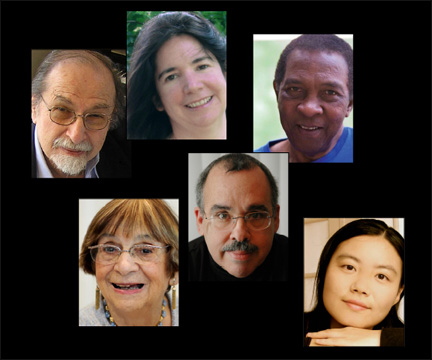Continuum in Review
Continuum Merkin Concert Hall, New York, NY May 1, 2011
Top: Elliott Schwartz, Ileana Perez Velázquez, Carman Moore; Bottom: Ursula Mamlok, Roberto Sierra, Wang Jie
You can be fairly sure you are at a Continuum concert when the “earliest” music on the program dates from 1998, when everything else is a New York or World Premiere, and when you hear music differently for at least several days afterward. Such was the case recently at Continuum’s 45th birthday concert. They continue, as they have indefatigably for decades, to bring us fascinating music by relative newcomers and composers of international stature.
U.S. composer Carman Moore (b. 1936) was featured first, in a work entitled “SHE” (An Appreciation – 2010) scored for an ensemble of four, including soprano, violin, clarinet, and piano. Organized according to what the composer describes as “the five archetypes of female life,” (from infancy through old age), this imaginative and involving work weaves quotes of Lord Byron, Lucretius, Sun Bu-Er, and Basho into the composer’s original text, a paean to women. An intriguing conception, its was brought to life appropriately by the four extremely gifted female performers.
Veteran Continuum violinist Renée Jolles shone next in a virtuoso performance of Sonata para violin y piano (2010) by Roberto Sierra (b. 1953). A tour de force requiring sensitive dovetailing with the pianist, precision in what Sierra calls “my own versions and transformations of Caribbean rhythms,” and tireless technique for just about every violin challenge in the book, it was handled with an ease that was impressive, especially considering that Ms. Jolles was engaged onstage for all of the roughly seventy minutes before intermission.
Using the same instrumentation as “SHE,” Continuum concluded its first half with “A Longing for Spring, A Multi-language Song Cycle” (2011) by Shanghai-born Wang Jie (b. 1980). Set to a Tang Dynasty poem by Tu Fu (712-770 AD) the work’s evocations of nature, war, torment, and tears were enhanced by super-titles and calligraphy projected onto a screen. There were so many ways to appreciate this composition, through sight, sound, and meaning, that interest never lapsed. One could not possibly grasp it all in a single hearing, but Ms. Wang’s multi-faceted work will undoubtedly earn future performances. She is certainly an artist to watch.
Some of my favorite music of the evening was in the opening of “Idolos del sueño” (“Dream Eidolons” – 2010) by Cuban-born Ileana Perez Velázquez (b. 1964). Soprano, clarinet, violin, cello, and piano conveyed the transparency of water and ephemeral reflections in an almost miraculous way, drawing the mesmerized listener into the world of Cuban poet Carlos Pintado. Not all of the work held me quite as strongly as the beginning, but I do look forward to hearing more by this talented composer.
Continuum paid tribute next to the 75th birthday of Elliott Schwartz (b. 1936) with a performance of his “Vienna Dreams” (1998), an appealingly nostalgic trio for clarinet, viola, and piano using fragments of Mozart, Schubert, and Brahms (and as the notes suggested, the presence of Mahler and Schoenberg hovering nearby). It was given a winning performance, as was the finale of the concert Mosaics (2011) by Ursula Mamlok (b. 1923). Mosaics, a four-hand piano work composed with a particularly artistic use of serialism, combined the forces of the ensembles founders, Joel Sachs and Cheryl Seltzer, in a fitting close to a celebration of 45 great years.
All works benefited from excellent performances of Mary Elizabeth Mackenzie, soprano; Moran Katz, clarinet; Renée Jolles, violin; Stephanie Griffin, viola; Christopher Gross, cello; Joel Sachs, piano; and Cheryl Seltzer, piano.
